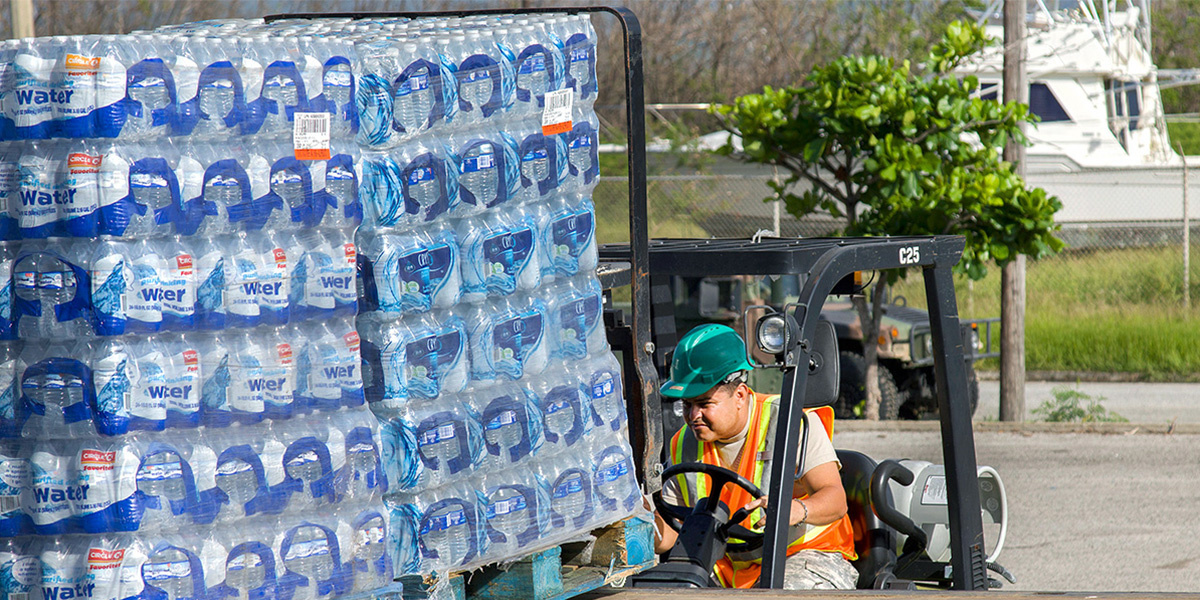
FEMA Left 20,000 Pallets of Water Bottles on Puerto Rico Runway for at Least Four Months

As the federal government prepares for Hurricane Florence this week, alarming photos are raising fresh questions about its response to Hurricane Maria last year.
The photos, first reported by CBS Wednesday after going viral on social media the day before, show potentially millions of water bottles sitting on a runway in Ceiba, Puerto Rico nearly a year after the storm.
BREAKING: What may be millions of water bottles. meant for victims of Hurricane Maria, have been sitting on a runway in Ceiba, Puerto Rico, since last year, according to @FEMA, which confirmed the news to me, late tonight, after pictures, posted today on social media, went viral. pic.twitter.com/jidGJAvCyJ
— David Begnaud (@DavidBegnaud) September 12, 2018
The water bottles were delivered to Puerto Rico by the Federal Emergency Management Agency (FEMA), Director of Disaster Operations Marty Bahamonde confirmed to CBS.
“If [FEMA] put that water on that runway there will be hell to pay … If we did that, we’re going to fess up to it,” a senior FEMA official told CBS News’ David Begnaud, who has covered the Maria recovery process extensively.
However, in an interview with CBS Thursday morning, FEMA Deputy Administrator Daniel Kaniewski defended the placement of the water bottles.
He said they were excess water bottles not needed during recovery that were taken out of storage and placed on the runway in January to save money.
“I’m confident that those that needed those bottles of water got them during the response phase and these were excess bottles of water that were, again, transferred to save money for the American taxpayer in January,” Kaniewski said.
The bottles were transferred to the Puerto Rican government in April, Kaniewski said, according to a transcript of the interview tweeted by Begnaud.
In a video posted on Twitter, Begnaud raised questions about Kaniewski’s answers.
“If you’re trying to save the taxpayer money, why wouldn’t you move it to another facility where you house supplies that can be used in a later disaster?” Begnaud asked.
Puerto Rico Federal Affairs Administration Executive Director Carlos Mercader confirmed the April transfer in a statement provided to CBS Wednesday.
According to that statement, a career official from Puerto Rico’s General Services Administration (GSA) requested the excess water bottles from FEMA on April 17 and the request was granted April 26.
The GSA claimed about 20,000 pallets of water, CBS reported.
On May 30, the government collected some of the water bottles from the landing strip and distributed 732 pallets of water between that date and Aug. 12, the statement said.
The government stopped distributing the bottles when they received complaints about the taste and odor of the water. The Puerto Rican government then decided to test the bottles and return them to the federal government.
The water bottles sat on the runway for four months before being passed off to the Puerto Rican government, according to Kaniewski ‘s own account.
Challenging Kaniewski’s timeline is the statement by a member of the Puerto Rico United Forces of Rapid Action Abdiel Santana, who took the photos of the bottles that began circulating on social media Tuesday.
He told CBS Wednesday he originally noticed the bottles last fall and took photos at the time.
Begnaud said on Twitter that blue shows up on satellite images of the runway starting in January.
The federal government’s response to Hurricane Maria has been in the news in recent weeks after the Puerto Rican government raised the official death toll from 64 to 2,975 this August.
In a press conference Tuesday, President Donald Trump dismissed those criticisms, saying his administration’s response to Hurricane Maria was “incredibly successful.”
San Juan Mayor Carmen Yulín Cruz criticized his self-congratulatory tone in an interview Tuesday, CNN reported, saying no public official should ever be content with everything they did in response to a disaster.
“But the president continues to refuse to acknowledge his responsibility, and the problem is that if he didn’t acknowledge it in Puerto Rico, God bless the people of South Carolina and the people of North Carolina,” Cruz said.
In a tweet Thursday, Trump doubled down, denying the accuracy of the revised death toll of nearly 3,000.
“3,000 people did not die in the two hurricanes that hit Puerto Rico,” Trump tweeted.
This rejection of the death toll in Puerto Rico, by the President of the United States, rejects facts. pic.twitter.com/rkgoGNwXn7
— David Begnaud (@DavidBegnaud) September 13, 2018
Cruz tweeted back her vehement disagreement, The Guardian reported Thursday.
“This is what denial following neglect looks like: Mr Pres in the real world people died on your watch. YOUR LACK OF RESPECT IS APPALLING!,” she wrote.
As #HurricaneFlorence Approaches, Document Shows Trump Admin Funneled Nearly $10 Million From FEMA to ICE https://t.co/TBUp734TOF
— EcoWatch (@EcoWatch) September 13, 2018

 233k
233k  41k
41k  Subscribe
Subscribe 